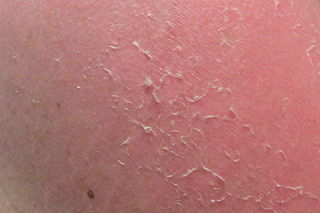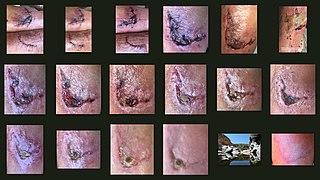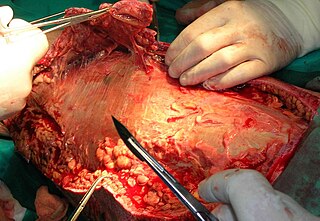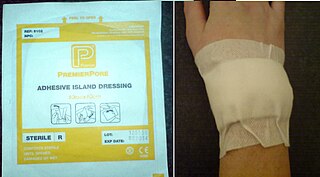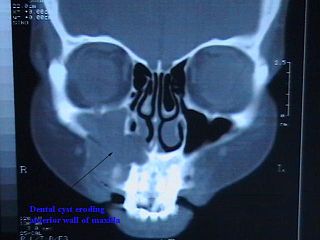This article needs additional citations for verification .(March 2019) (Learn how and when to remove this template message) |
Sloughing (pronounced "sluffing") in biology refers to the act of shedding or casting off dead tissue, such as cells of the endometrium, shed during menstruation, or the shedding of skin in amphibians.
Biology is the natural science that studies life and living organisms, including their physical structure, chemical processes, molecular interactions, physiological mechanisms, development and evolution. Despite the complexity of the science, there are certain unifying concepts that consolidate it into a single, coherent field. Biology recognizes the cell as the basic unit of life, genes as the basic unit of heredity, and evolution as the engine that propels the creation and extinction of species. Living organisms are open systems that survive by transforming energy and decreasing their local entropy to maintain a stable and vital condition defined as homeostasis.

The endometrium is the inner epithelial layer, along with its mucous membrane, of the mammalian uterus. It has a basal layer and a functional layer; the functional layer thickens and then is shed during menstruation in humans and some other mammals, including apes, Old World monkeys, some species of bat, and the elephant shrew. In most other mammals, the endometrium is reabsorbed in the estrous cycle. During pregnancy, the glands and blood vessels in the endometrium further increase in size and number. Vascular spaces fuse and become interconnected, forming the placenta, which supplies oxygen and nutrition to the embryo and fetus. The speculated presence of an endometrial microbiota has been argued against.

Menstruation, also known as a period or monthly, is the regular discharge of blood and mucosal tissue from the inner lining of the uterus through the vagina. The first period usually begins between twelve and fifteen years of age, a point in time known as menarche. However, periods may occasionally start as young as eight years old and still be considered normal. The average age of the first period is generally later in the developing world, and earlier in the developed world. The typical length of time between the first day of one period and the first day of the next is 21 to 45 days in young women, and 21 to 31 days in adults. Bleeding usually lasts around 2 to 7 days. Menstruation stops occurring after menopause, which usually occurs between 45 and 55 years of age. Periods also stop during pregnancy and typically do not resume during the initial months of breastfeeding.
Skin sloughing is the process of shedding dead surface cells from the skin.
Skin sloughing is the process of shedding dead surface cells from the skin. It is most associated with cosmetic skin maintenance via exfoliation, but can also occur biologically or for medical reasons.
In veterinary medicine, it may refer to the process where necrotic surface epithelial cells are discarded from the small intestinal mucosa following various infections which may occur within both monogastrics or ruminants. [1]

Veterinary medicine is the branch of medicine that deals with the prevention, diagnosis and treatment of disease, disorder and injury in non-human animals. The scope of veterinary medicine is wide, covering all animal species, both domesticated and wild, with a wide range of conditions which can affect different species.

Necrosis is a form of cell injury which results in the premature death of cells in living tissue by autolysis.
A monogastric organism has a simple single-chambered stomach, compared with a ruminant organism, like a cow, goat, or sheep, which has a four-chambered complex stomach. Examples of monogastric animals include omnivores such as humans, rats, dogs and pigs, carnivores such as cats, and herbivores such as horses and rabbits. Herbivores with monogastric digestion can digest cellulose in their diets by way of symbiotic gut bacteria. However, their ability to extract energy from cellulose digestion is less efficient than in ruminants.
In medicine, slough may start occurring in pressure ulcers also known as decubitus ulcers or as bed sores at the stage 3, and in stage 4[ clarification needed ] levels of wound, infection, and damage.[ citation needed ]

Medicine is the science and practice of establishing the diagnosis, prognosis, treatment, and prevention of disease. Medicine encompasses a variety of health care practices evolved to maintain and restore health by the prevention and treatment of illness. Contemporary medicine applies biomedical sciences, biomedical research, genetics, and medical technology to diagnose, treat, and prevent injury and disease, typically through pharmaceuticals or surgery, but also through therapies as diverse as psychotherapy, external splints and traction, medical devices, biologics, and ionizing radiation, amongst others.

Pressure ulcers, also known as bedsores, decubiti, decubitous ulcers, pressure injuries, and pressure sores, are localized damage to the skin and/or underlying tissue that usually occur over a bony prominence as a result of usually long-term pressure, or pressure in combination with shear or friction. The most common sites are the skin overlying the sacrum, coccyx, heels, and hips, though other sites can be affected, such as the elbows, knees, ankles, back of shoulders, or the back of the cranium.
In plants, sloughing occurs during root growth, where cells from the root cap are shed to the soil where they are biologically processed by microorganisms. Also, when a root undergoes secondary growth (transition from a primary root to a "woody" root), the cortex and epidermis become isolated from the rest of the root and are eventually sloughed.[ citation needed ]

The root cap is a type of tissue at the tip of a plant root. It is also called calyptra. Root caps contain statocytes which are involved in gravity perception in plants. If the cap is carefully removed the root will grow randomly. The root cap protects the growing tip in plants. It secretes mucilage to ease the movement of the root through soil, and may also be involved in communication with the soil microbiota.

A cortex is the outermost layer of a stem or root in a plant.
